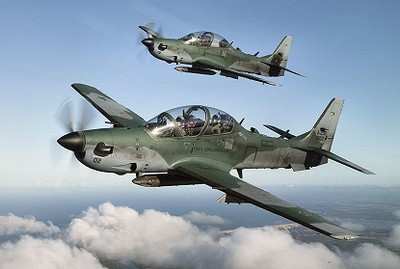A Fine Bird in Any Jungle
Embraer S.A., the multinational aerospace manufacturer of commercial, military, executive, and agricultural aircraft founded in 1969 and headquartered in São Paulo, Brazil, announced that it had signed an agreement by which the Brazilian OEM would support the Philippine Air Force’s fleet of A-29 Super Tucano aircraft.

Subject agreement will provide support for more than two-hundred A-29 Super Tucano part numbers.
Rinaldo Piubeli Prado, Embraer services & support vice president stated: “Staying close to our customers and supporting them in their missions is core to what we do. Leveraging on our customer support team in Asia Pacific, we are honored to support the Philippine Air Force as they deploy the A-29 and utilize it to its fullest potential.”
Delivered in 2020, the Philippine Air Force’s fleet of six A-29 Super Tucano single-engine turboprop aircraft reflect Embraer’s commitment to the Pacific island nation, and serve its Air Force’s 15th Strike Wing.
In 2022, Embraer’s worldwide fleet of A-29 Super Tucanos surpassed 500,000 flight hours. To date, the robust aircraft, of which more than 260 units have been delivered, has been selected by more than 15 air forces worldwide.
The EMB 314 Super Tucano (English: Toucan)—known also as the ALX or A-29—is a turboprop light attack aircraft evolved from Embraer’s EMB 312 Tucano. The A-29 Super Tucano is a low-cost aerial combat platform designed for operation in low-threat environments. The aircraft carries a wide variety of weapons—particularly of the ground-support/air-to-ground variety.
The A-29 Super Tucano is powered by a single, 1,600-shaft-horsepower, Pratt & Whitney PT6A-68C turboprop engine turning a 5-bladed Hartzell, 7-foot-10-inch diameter constant-speed, fully feathering, reversible-pitch propeller. The aircraft’s airframe is rated to +7 and -3.5 Gs, and has a fatigue life of 8,000 to 12,000-hours in operational environments. The A-29’s reinforced landing gear facilitates takeoff weights as high as 11,905-pounds, to include a munitions load of up to 3,420-pounds.

A-29 pilots are protected by Kevlar armor and a side-hinged canopy capable of withstanding bird-strikes at speeds as high as 270-knots. Offensively, Tucano pilots may avail themselves of two internal, wing-mounted .50 caliber machine guns (with two-hundred rounds of ammunition each), and five weapon hard-points capable of accommodating Giat NC621 20-mm cannon pods, Mk 81/82 bombs, MAA-1 Piranha air-to-air missiles (AAMs), BLG-252 cluster bombs, and SBAT-70/19 or LAU-68A/G rocket pods.
The Super Tucano’s glass-cockpit features night-vision compatibility, Hands-On-Throttle-And-Stick (HOTAS) controls, and has provision for a datalink, a video camera and recorder, an embedded mission-planning capability, forward-looking infrared, chaff/flare dispensers, missile approach warning receiver systems and radar warning receivers, and tandem, zero-zero ejection seats.
The A-29 Super Tucano’s flight envelope is bounded by a Vne of 320-knots and a Vso stall-speed of 80-knots. The aircraft’s 720-nautical-mile range is consistent with its three-hundred-nautical-mile combat range and 1,542-nautical-mile ferry range. The A-29 has a service-ceiling of FL350, to which it ascends—initially, anyway—at a climb-rate of 3,230-foot-per-minute.
Parties interested in acquiring a Super Tucano for personal use—and God in his Heaven knows it’d be a superb aircraft in which to tear around—will need coin enough to cover an initial outlay of $18-million and significant per-hour operating costs.
 ANN's Daily Aero-Term (05.10.24): Takeoff Roll
ANN's Daily Aero-Term (05.10.24): Takeoff Roll Aero-News: Quote of the Day (05.10.24)
Aero-News: Quote of the Day (05.10.24) Airborne 05.06.24: Gone West-Dick Rutan, ICON BK Update, SpaceX EVA Suit
Airborne 05.06.24: Gone West-Dick Rutan, ICON BK Update, SpaceX EVA Suit Airborne 05.03.24: Advanced Powerplant Solutions, PRA Runway Woes, Drone Racing
Airborne 05.03.24: Advanced Powerplant Solutions, PRA Runway Woes, Drone Racing Aero-News: Quote of the Day (05.11.24)
Aero-News: Quote of the Day (05.11.24)




